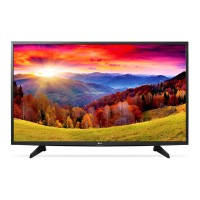ENGLISH
• Check the power and Ethernet cables of the Wi-Fi router.
- When the Ethernet cable connected to the Wi-Fi router is loose or disconnected, network problems can
occur.
• Check all power and Ethernet cables of the Wi-Fi router to see if they are correctly connected.
• Check the Wi-Fi router to see if the router is set to the recommended wireless settings. If network problems
continue, reset your network devices.
• Check the signal strength of the Wi-Fi router to connect to from the TV UI.
- The that is next to the Wi-Fi router name (SSID) in the menu indicates the sensitivity of the receiver.
- It is recommended that you connect to a Wi-Fi network with 3 or more bars of signal strength.
- If the number of bars indicating signal strength are less than 3, the network connection status may be weak
or unstable, so shorten the distance between the Wi-Fi router and the TV.
• If the signal strength of the Wi-Fi router is weak, wireless speed slowdowns and network disconnection may
occur.
• To supplement wireless coverage of network equipment, your Wi-Fi router should be placed in the middle of
the network equipment.
Wi-Fi Router
• Interference Factors
If there is any interference from surrounding equipment, the network connection may be weak or unstable.
- Wireless telephones that operate in the 2.4 GHz or 5 GHz bandwidth
- Wireless speakers that operate in the 2.4 GHz or 5 GHz bandwidth
- Video transmitters that operate in the 2.4 GHz or 5 GHz bandwidth
- Other wireless devices (Microwaves, cameras, baby monitors, neighboring wireless devices, etc.) that
operate in the 2.4 GHz or 5 GHz bandwidth.
• How to reduce the effects of interference between Wi-Fi and Bluetooth devices
- Set the channel on your wireless network equipment to avoid the 2.4 GHz or 5 GHz bandwidth which has
lots of interference.
- If possible, use the 5 GHz wireless network.
- If the Wi-Fi router is located too far away or in environments with high interference, the network connection
may be weak or unstable.
- In this case, move the Wi-Fi router closer to the TV or check if there are any obstructions (e.g., concrete walls,
cabinets) between the two devices.
• Radio Frequency (RF) Interference and Absorbing Obstructions
Type of Barrier
Interference
Potential
Type of Barrier
Interference
Potential
Type of Barrier
Interference
Potential
Wood Low Water Medium Plaster High
Synthetic material Low Bricks Medium Concrete High
Glass Low Marble Medium Bulletproof glass High
Metal Very High

